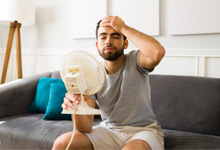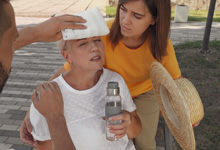
Hey, cool it! On a hot day, sometimes even the body’s own cooling system (sweat) is not enough to bring temperatures down. If that’s the case, you run the risk of heat exhaustion or even its potentially deadly successor heat stroke.
How can you tell the difference between heat exhaustion and heat stroke – and avoid both – to get on with your day of fun in the sun?
Experts from Hoag’s 15 urgent cares and two Emergency Departments have put together some telltale signs and tips because Hoag has your (well-sunscreened) back.
 Heat Exhaustion can be caused by water depletion (which leads to excessive thirst, weakness, headache and unconsciousness) or salt depletion (which can cause nausea, vomiting, muscle cramps and dizziness).
Heat Exhaustion can be caused by water depletion (which leads to excessive thirst, weakness, headache and unconsciousness) or salt depletion (which can cause nausea, vomiting, muscle cramps and dizziness).
 Treatment for Heat Exhaustion includes cooling down through fans, ice or cold water and the avoidance of caffeine, alcohol and tight clothing.
Treatment for Heat Exhaustion includes cooling down through fans, ice or cold water and the avoidance of caffeine, alcohol and tight clothing.
 Heat Stroke occurs when the body becomes unable to control its temperature, rising to 106°F or higher within 10 to 15 minutes! Heat stroke can cause death or permanent disability if emergency treatment is not given. Symptoms include confusion, altered mental status, slurred speech and loss of consciousness, as well as seizures and high body temperature.
Heat Stroke occurs when the body becomes unable to control its temperature, rising to 106°F or higher within 10 to 15 minutes! Heat stroke can cause death or permanent disability if emergency treatment is not given. Symptoms include confusion, altered mental status, slurred speech and loss of consciousness, as well as seizures and high body temperature.
 Treatment for Heat Stroke. First, call 911. Move the person to a cool, shady area and try to get their body temperature down. A cold water or ice bath is preferable, but at the very least place cold, wet towels on the person’s head and neck and make sure air is circulating around them until help arrives.
Treatment for Heat Stroke. First, call 911. Move the person to a cool, shady area and try to get their body temperature down. A cold water or ice bath is preferable, but at the very least place cold, wet towels on the person’s head and neck and make sure air is circulating around them until help arrives.
Hoag has two Emergency Departments in Irvine and Newport Beach and 15 urgent care facilities throughout Orange County.









